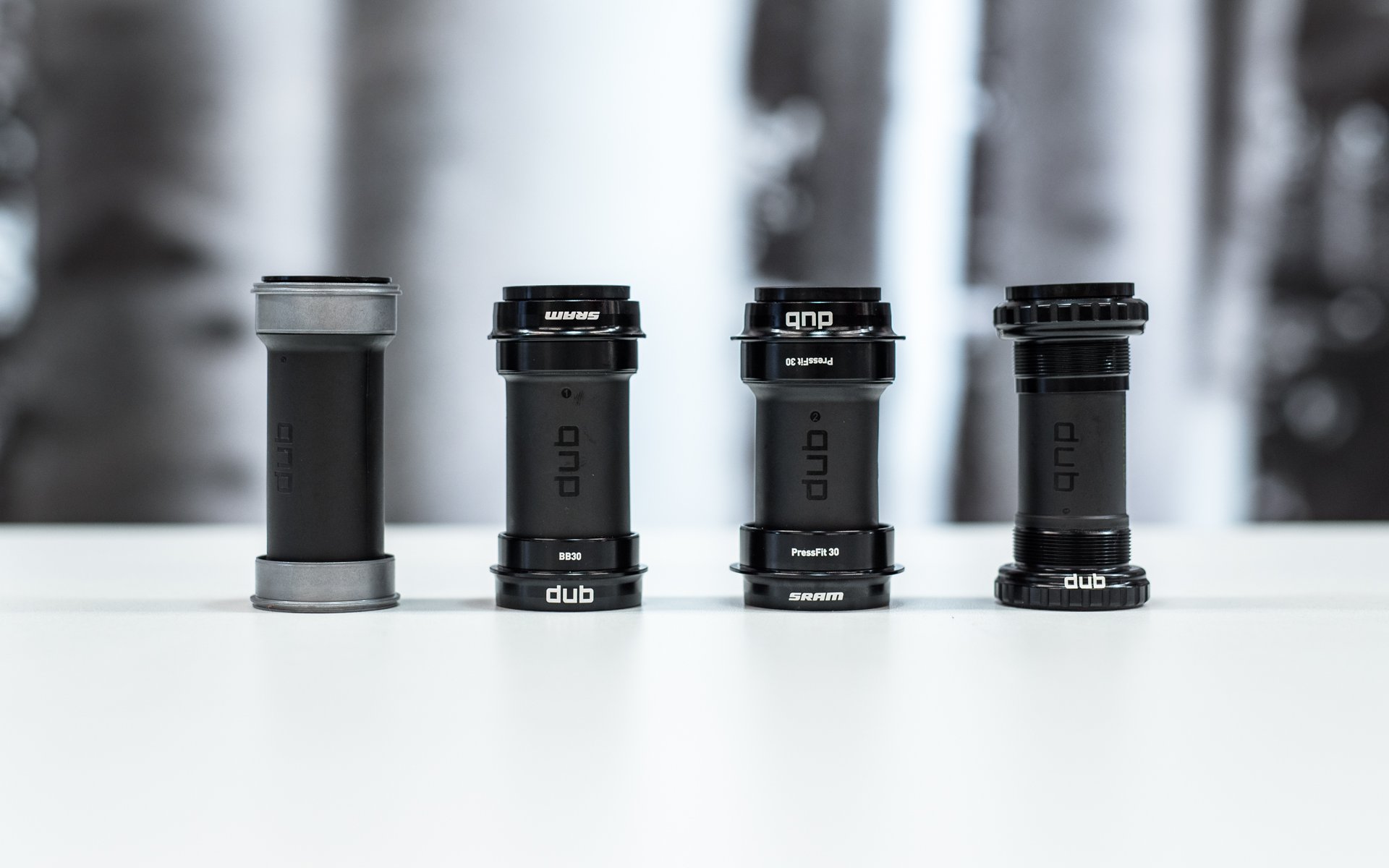
Editorial
Standard Issues
"Have you seen this new f***ing DUB bullsh*t from SRAM?"
Well, it's not really new. I mean, that sh*t storm sort of blew over a couple of months ago. And it was a silly thing to get all vitriolic about, to begin with.
"Yeah, but f*** them, I'll never buy SRAM cranks now."
Okay, I have a couple of general thoughts on this, next round's on you by the way, but one specific question first. Haven't you done a custom spec for every bike you've bought since the 90's?
"Well yes but..."
And, haven't you put a set of Race Face cranks on Every Single One of those bikes?
"Well yes..."
So when exactly were you planning to buy an SRAM crankset anyways?
"... "
I've got 29 problems...
...and DUB ain't one.
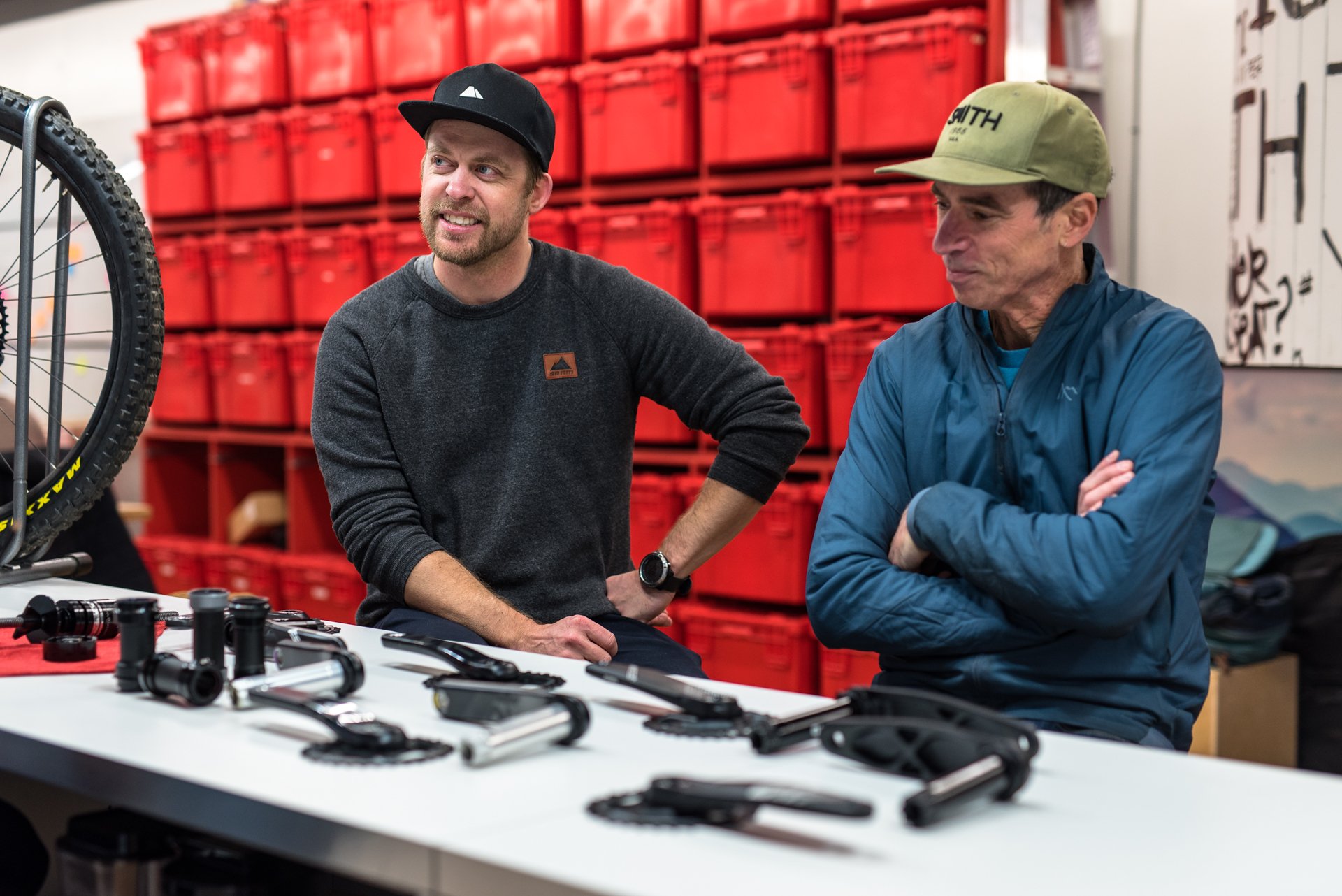
WTF is DUB? Cam, Pete, and Dave Smith were on hand for the unveiling. You can check out all the info and pretty pictures here.
"But, what about needing new tools!"
What new tools? Pressfit is Pressfit. For BSA, DUB uses the same BB installation tool as the original Zipp VumaQuad which was the first crankset to combine a 30mm alloy spindle with BSA bottom bracket compatibility.
That's the same tool that Race Face and Rotor use to install their BSA 30mm BB as well and really if anyone is a jerk here it's all the companies that came up with their own BSA 30mm tool standards after that. I'd say more but here's a photo from the Friar that perfectly sums up the sheer ridiculousness of BSA 30mm bottom brackets.
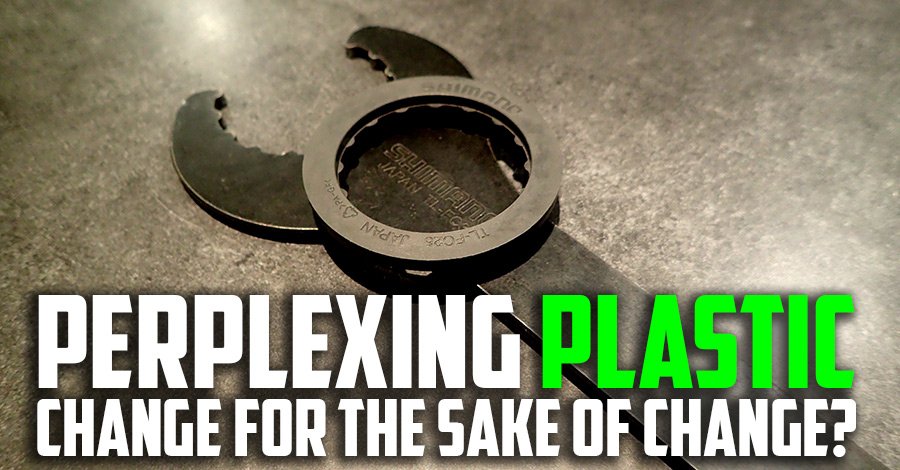
Tool Standards: Shimano quietly changed the outer diameter of their BSA cups, requiring a new tool or crappy plastic adapter, and no one gave a shake. Photo: AM
I don't know why SRAM released the 28.99mm bottom bracket (BB) standard* at a time of year when the weather is absolutely sh*t for a large percentage of bike nerds. I mean, what response do you expect from a bunch of dirt junkies months deep in withdrawal?For that matter why make such big deal out of it, to begin with? There is nothing sexy about marketing a new BB standard. How about a quiet rollout with awesome spare parts support?
Anyways, back to the pub.
*No, it's not a de facto standard, but it's not like there was one anyways. It certainly qualifies as a new technical standard.
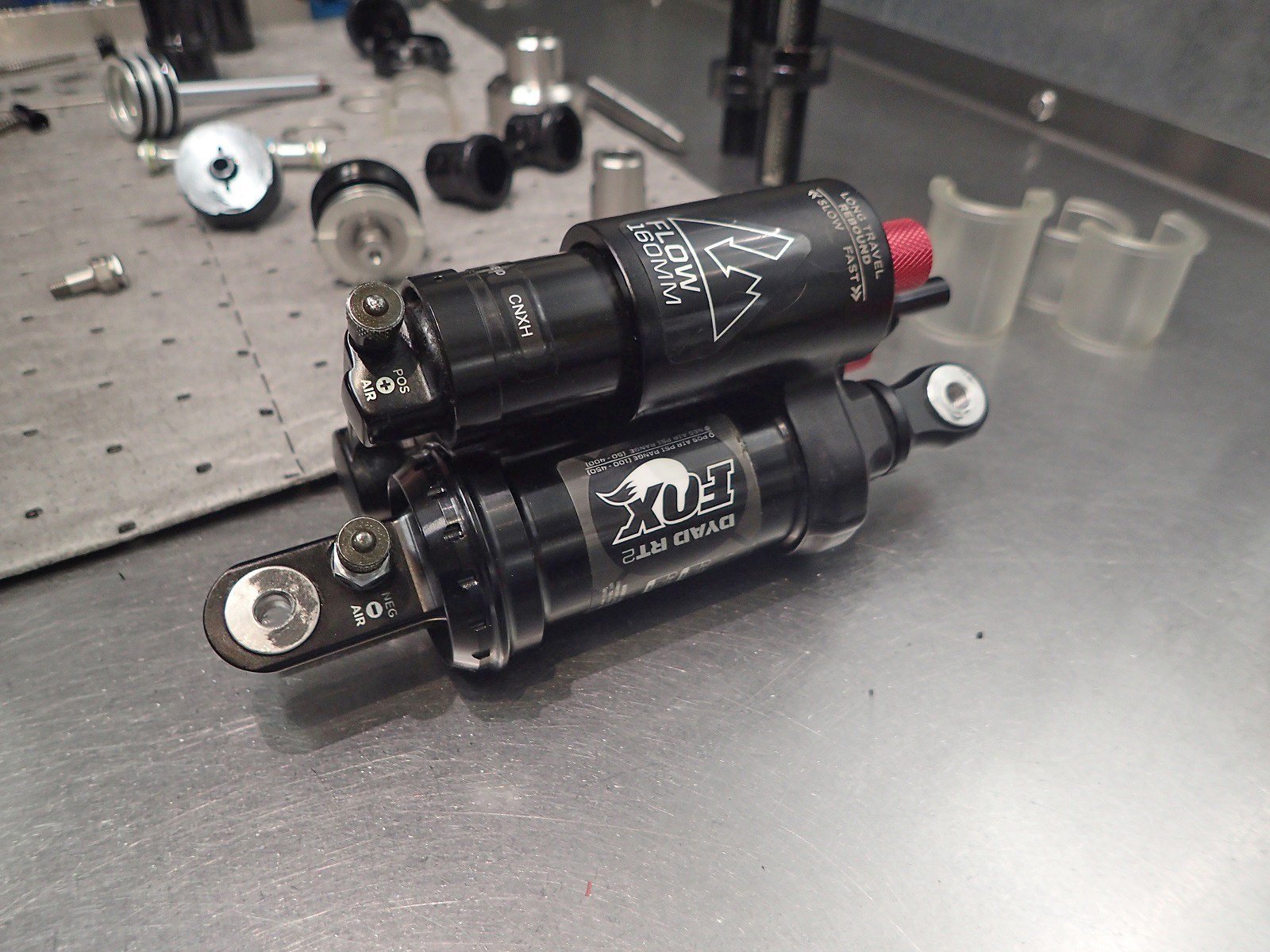
Shock Standards: I love the performance and construction of the Fox-Cannondale DYAD pull-shock collaboration but it goes against my personal purchasing principle of swap-ability. Photo: AM
"Yeah, but no one asked for DUB. There's nothing wrong with the 30mm and 24mm standards."
Actually, I'm sure there were more than a few weighted requests that resulted in DUB since SRAM has been pushing Eagle systems as crate drivetrains. Any brand using the PF92 bottom bracket standard was forced to buy GXP cranksets in a world that accepts Shimano or 30mm. I think Trek, Giant, Kona, Rocky Mountain, and a plethora of other brands probably asked for reliable PF92 bottom bracket paired with a lighter alloy spindle.
Besides, given that the vast majority of DUB cranksets will be sold OE, what if the BB reliability is actually WAY better? I'm trying not to be a cynical prick but SRAM bottom brackets aren't exactly appreciated when it comes to reliability and their cranks come on a lot of performance mountain bikes. The net benefit could be great.
The vast majority of riders won't care what's pressed in their frame as long as their local shop has them in stock. And please, don't start with the burden of shops maintaining an inventory of four additional SKUs. They add more derailleur hangers to their system in a month.
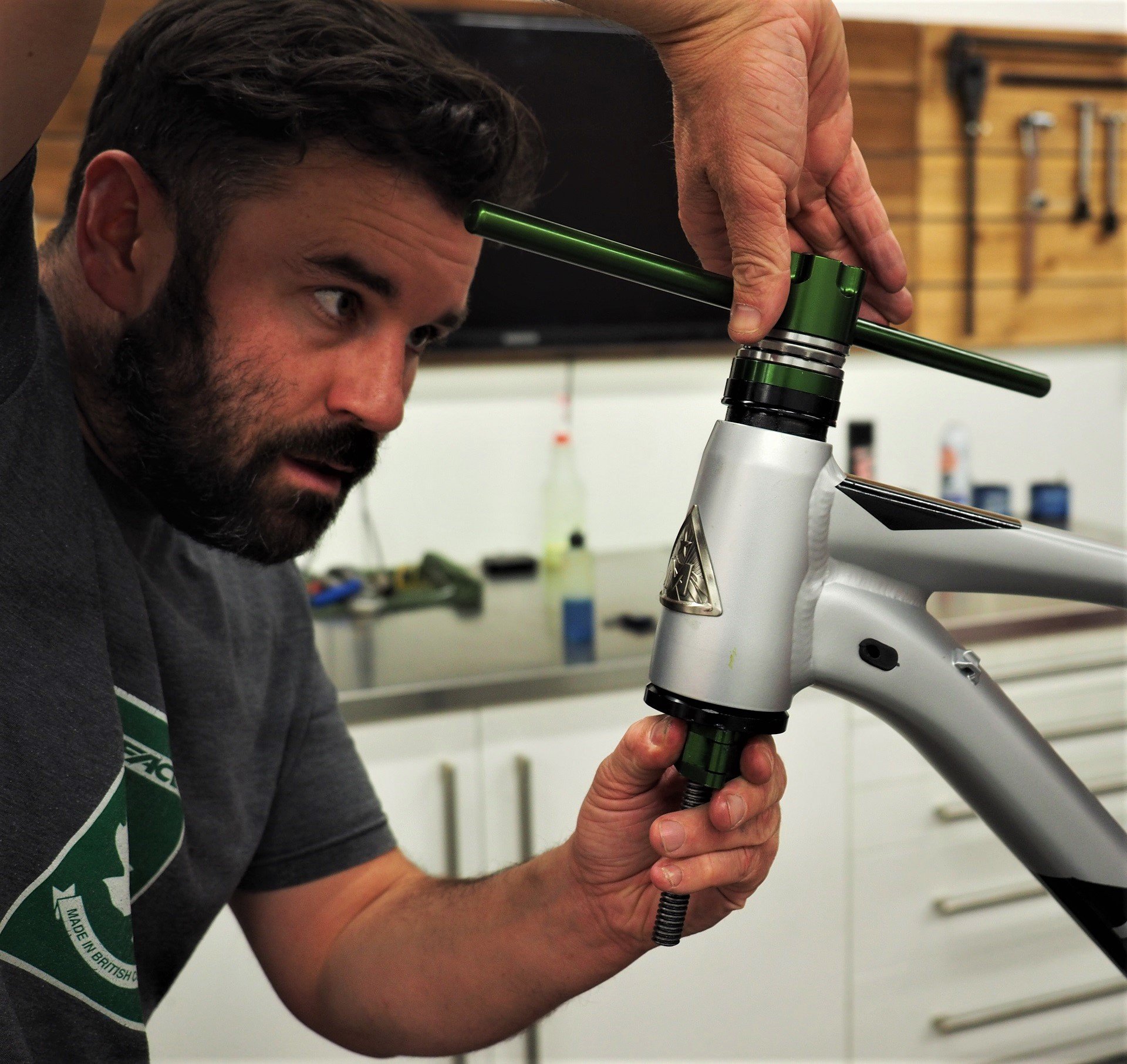
Headset Standards: I welcome the rising dominance of the 44/56 headset as the de facto standard. No, it's not functionally better than other options. Photo: AM
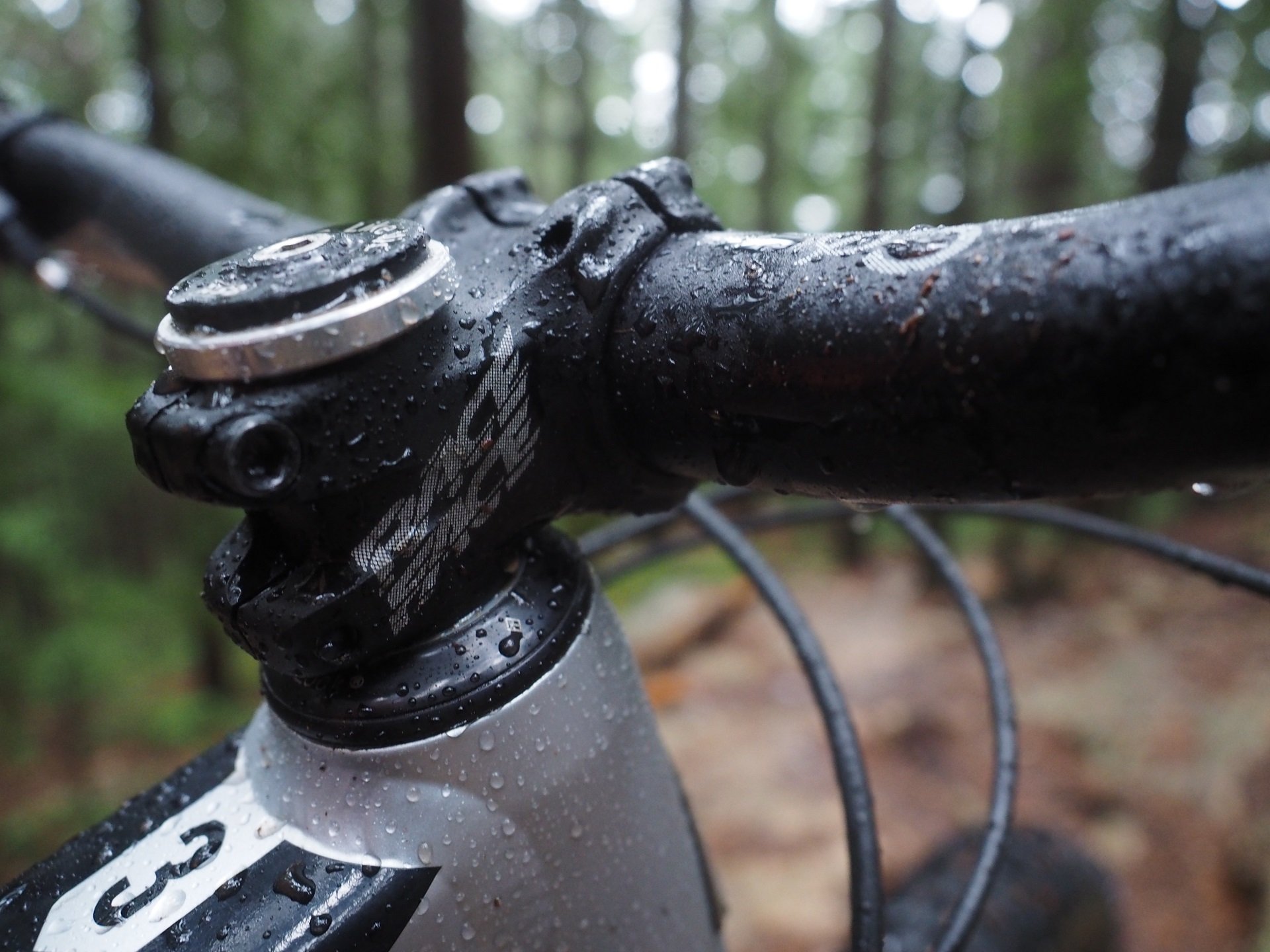
But, I like buying one headset and having almost limitless options for the next frame I press it into. Photo: AM
"Okay, well what if there is an initial shortage of BB inventory and riders are stuck without being able to replace a blown DUB BB?"
It wouldn't be fair to bet you that an aftermarket option will exist before then. Why don't we place odds on how many manufacturers out of Enduro, Wheels Manufacturing, Praxis, Hope, Chris King, and White Industries have a replacement option ready by Sea Otter? Hell, if I was Race Face I'd be selling a $10 sleeve kit to make my current Cinch PF92/30mm bottom brackets DUB compatible next week.
DUB cranks are going to come on half the mountain bikes over 3500 USD next year. In addition to the cheddar being made off bottom bracket sales, I'd bet the likes of Wolftooth, OneUp, and Blackspire are ready to pump out more SRAM-compatible aftermarket chainrings too. Especially since so many product managers seem to think that we all want a 34t ring with our Eagle drivetrain.
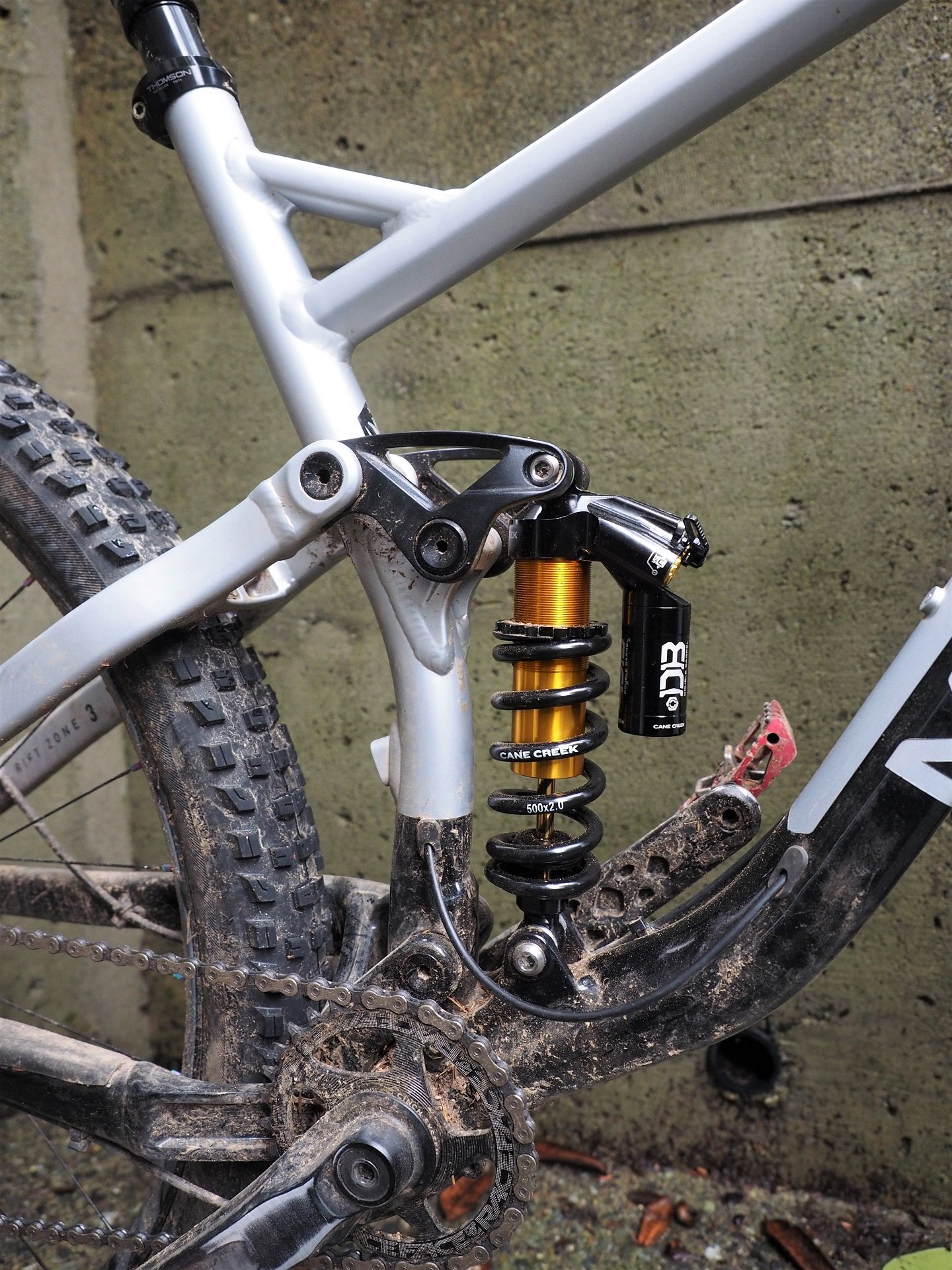
Shock Mount Standards: I haven't had a negative experience with a trunnion mounted shock but for my money, I'll take the easy swap-ability of standard eyelets. Photo: AM
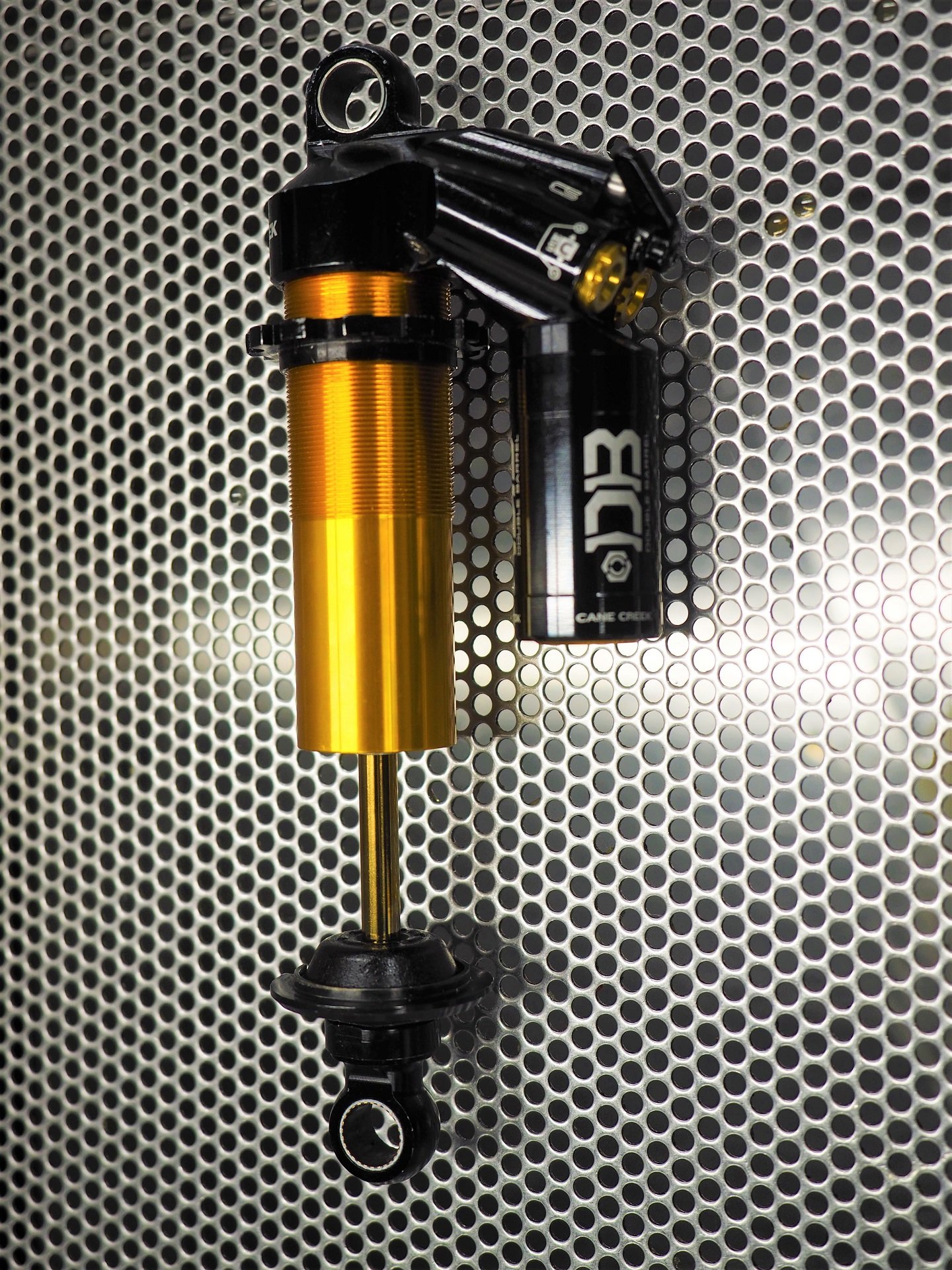
My frame uses a Metric standard shock but all SuspensionWerx needed was a shaft, spacer, and service to adapt this used CCDB to fit. Photo: AM
"Wait, so why do I care about DUB?"
A better question is why does anyone care about DUB? Other than the person buying a complete bike, with a PF92 bottom bracket, who may get a better life out of their BB. GXP and 30mm cranksets will be supported with aftermarket bottom brackets effectively forever and I'd be surprised if DUB actually affects a single bike or crankset purchasing decision (for or against).
You haven't ridden in sunshine since September and it's currently snowing again. Nerd raging about bicycle sh*t has replaced the time you normally spend riding or pondering potential upgrades when parts are breaking, wearing out, or looking less shiny. But, there are WAY bigger bicycle boondoggles to be mad about.
Do you want to talk about chainstays that are too long (or too short), seat angles that are too slack (or too steep), companies making their reach numbers look more impressive by shortening Stack heights, the practical 34.9 seat post standard dying on the vine, why 35mm handlebars are stupid, how a true DH tire delivers the benefits of Plus sizing without clearance or compatibility issues for the same weight, discuss mineral oil vs DOT fluid for brakes, or do you want to tell me again about why 157mm hub spacing is better?
"Well what about grips then... Renthal Super Tacky Push-On or Sensus Swayze push-on?"







Comments
legbacon
6 years, 1 month ago
Riding in sunshine today:)
Reply
John Forsythe
6 years, 1 month ago
"Especially since so many product managers seem to think that we all want a 34t ring with our Eagle drivetrain. "
This.
Why is it so difficult to just spec a bike with a 1x drive train, 30 tooth front ring? From there the consumer can go up or down depending on their legs. Would save a lot of dollars on mas production by just having one setup per group set vs two.
As for DUB. Who cares. If it works it will endure. If not, not.
And I rode in sun both days this weekend in WA. :)
Reply
Andrew Major
6 years, 1 month ago
Some bikes are certainly designed to pedal better with larger rings - like a 34 - but I’d certainly argue that 30t would be a better nominal size for 29’ers.
This is especially true for bikes with really steep STAs because spinning higher cadences works much better with those setups.
Reply
Kyle Rosten
6 years, 1 month ago
What I get out of this is that it’s snowing again down there? heading to ride Vedder on Thursday. Thought it had been warming enough to ride dirt without going all the way to Gibsons again.
Angry noises. I’ll blame it on DUB.
Reply
Andrew Major
6 years, 1 month ago
Much more riding has opened up since the genesis of this.
Was riding on the SSC yesterday actually.
Reply
Kyle Rosten
6 years, 1 month ago
Awesome! Thanks for the reply
Reply
T-mack
6 years, 1 month ago
Rode Vedder yesterday. Dilemma down is prime. More trails might be opening up as the weather was warm today.
Reply
M.E
6 years, 1 month ago
Well I don't really care about DUB, but I do care enough to know that it's 28.99mm and not 29.88 mm ;)
Reply
Andrew Major
6 years, 1 month ago
Hahahahaha - that’s what you get when you spend two days with Jay-Z stuck in your head!
Thanks!
Reply
JT
6 years, 1 month ago
As someone who still has bins of 115, 118, 122mm JIS square taper BB's (in Italian, French, and English thread) and a few 111 ISO (English, Italian, and Swiss) square tapers at the shop, I never understood the uproar over DUB, and I am by no means a SRAM fan. Their Powerspline BB causes me more grief than I see DUB ever causing.
Reply
Andrew Major
6 years, 1 month ago
Jeeze, mostly legacy stuff or do you still sell much square taper?
I know there’s some demand for Campy and JIS in BSA but figured everything else would be special order.
Reply
JT
6 years, 1 month ago
The JIS BSA generally have turns with people replacing worn out units or doing a single speed conversion. The Swiss Phil Wood BB is likely going to be in inventory for an additional 10-15 years. Should capitalize well in the vintage market at that point. Heck, let's not even talk about both Octalink varieties and ISIS. My point is that standards are not what people think they should mean. And Powerspline BB's are terrible. Given the shear variety of BB's we see from the past, why freak out when a company makes a unit to fit modern frame standards and their cranks only? It's not like it's the first time they or anyone else have done it. If it works, aces, if it provides no real change, then we can bemoan them.
Reply
Andrew Major
6 years, 1 month ago
I still remember when external BBs hit the scene. Even with all the issues with Octalink and Isis - and the weight of the 19mm Profile cranks a lot of my friends were running - there was certainly reluctance to adopt them.
Thanks for the perspective!
Reply
Niels van Kampenhout
6 years, 1 month ago
"companies making their reach numbers look more impressive by shortening Stack heights"
Please write an article about this! :-) It also makes the effective STA look steeper. Most people don't seem to realize/understand this when comparing geos. I have a 100% failure rate in trying to explain this so I need an online article I can point to :-)
Reply
Andrew Major
6 years, 1 month ago
I’ve read some decent attempts at simple explanations of the relationship of Reach, Stack, STA, and HTA.
I don’t have a silver bullet explanation to put on paper.
Reply
Cr4w
6 years, 1 month ago
We believe in you.
Reply
Dan V
6 years, 1 month ago
I support this kind of research. Show us the wisdom of measuring the hypotenuse (of stack and reach, and I guess stem length and bar width) and how it figures into leverage.
Last time I looked into applying actual geometry logic to bikes, I only ended up asking why there needed to be a seat tube in the first place. shrug
Reply
Shoreboy
6 years, 1 month ago
I'll bite. Im not sure what you mean by shortening stack heights? Its supposed to be a defined measurement.
""Stack” is the vertical distance, in centimeters*, from the center of the frame's bottom bracket/crank to the top middle point of the head tube (where the fork passes through the frame)."
*Or in inches if you are so inclined...
Reply
Andrew Major
6 years, 1 month ago
I'm not sure what you're biting on. Maybe I could have phrased the original sentence better in the piece.
You're correct, that's the definition of Stack and it's a standard measurement but it's a variable dimension (for example a taller headtube will result in a larger Stack height)
Since Reach is measured in relation to Stack (at the top middle point of the head tube) a bike with a big Stack number and the same Reach number will have a significantly longer front-center than a bike with the same Reach number and a short stack height.
So if company X has a 500mm Reach and a 650mm Stack that bike will fit significantly larger than company Y's bike with a 500mm Reach and a 600mm Stack.
Reply
Niels van Kampenhout
6 years, 1 month ago
The issue is that people compare reach numbers of frames, saying that one has a longer reach than the other, without taking stack height into account. If one frame has a much lower stack height than the other, to get the same fit on both you would have to add headset spacers to increase the stack height to be the same. Because of the slack head angle, this effectively shortens reach, in some cases this means that the frame with the longer reach number on paper is actually shorter in reality.
Reply
Shoreboy
6 years, 1 month ago
If people are comparing frames based on reach alone (and not factoring in stack), then they arent understanding bike geometry very well. Once you look at the reach and stack numbers on a few bikes, you can quickly see that they need to be considered together to make bike to bike comparisons.
Reply
Andrew Major
6 years, 1 month ago
Absolutely.
That’s the issue with Reach and HTA being the only numbers a lot of riders look at/refer too.
The point I was trying to make is new bike models getting slightly longer Reach numbers (without increases in Stack) aren’t really growing much relative to the effective rider position which is an aggregate of all the frame numbers.
Reply
Liam Allen
6 years, 1 month ago
Ive always though wheelbase, chainstay length, head angle and seat angle to be far more usefull numbers than reach or top tube length or front centre etc.
Andrew Major
6 years, 1 month ago
@Liam, I don’t think wheelbase (and weight balance) are considered enough especially in conversations like those about Transition’s SBG where riders are looking at offset, stem length, and HTA.
One of the beautiful things about single speeds has been the opportunity to play with wheelbase via sliders and gear ratios.
Everything is relative and obviously super short stays make sense in many situations (DJ for example) but the result of playing around a lot is, I’m not a fan of ‘tucked’.
After riding my Honzo, Explosif, and the NSMB test Stache with the wheelbases set full long I went with a 440mm+ rear centre (1190mm wheelbase) on my new ~ medium sized hardtail. Weight balance is beautiful climbing and descending even if manuals/wheelies are a bit harder.
My Marin Rift Zone is at 435mm and I wouldn’t want shorter for the same reason - balance.
Now how much of that is personal preference vs. trends vs. what’s actually better?
Lynx .
6 years, 1 month ago
Well, actually, if Stack and Reach are the only numbers you're looking at, then you too are also just barely missing. You have to also take BB drop into account, because if there are 2 frames and both have a 485mm Reach, but one has a 650 Stack and the other has a 630 Stack, but also the one with the shorter stack also has more BB drop, then the Stack height doesn't have to be as tall to give the same relative saddle to bar relationship as on the other which has less BB drop ;-)
Reply
Shoreboy
6 years, 1 month ago
This makes no sense to me. BB Drop is measured to the rear dropouts, and would have no effect on stack or reach. It simply states how far below (or above if you have BB Rise) the BB is in relation to the rear dropout.
Lynx .
6 years, 1 month ago
Of course it makes sense, frames are designed around a certain fork A2C which determines listed Stack and then BB drop is how low below the centre line of the axles the BB sits, so if you have 2 identical frames geo wise, except one has a 20mm lower BB drop, then your saddle will be 20mmm lower than on the other, hence you will also not need to raise the bar as much, thereby making the effective Reach actually longer on the one with the lower BB.
"SHOREBOY = This makes no sense to me. BB Drop is measured to the rear dropouts, and would have no effect on stack or reach. It simply states how far below (or above if you have BB Rise) the BB is in relation to the rear dropout."
Reply
Andrew Major
6 years, 1 month ago
I’m not following you either.
If we were talking about the relation of seat height to bar height this would make perfect sense. More BB drop means a lower ground to saddle height and so for a fixed a2c height the bar height, relative the ground or hub axle, will be physically lower irrelevant to the Reach and Stack numbers.
Reach and Stack measurements though are based off the BB so I don’t see how a2c height or the BB position relative the axles or any measurement (saddle, BB, bar) vs. the ground is relevant?
Anyways, it isn’t obvious to me. Can you please further explain?
Lynx .
6 years, 1 month ago
OK guys, will have to admit to having a brain scramble on how Stack is measured, holy brain fart. My bad, I apologize for that.
Just experienced this phenomenon with my new XL Unit, which only has a 5" HT - even running miss-matched wheel sizes with a 29+ in the front, B+ rear, I still have to run about 35-40mm of spacers under the stem to get the bar up to where I like it, which has effectively brought the Reach down significantly coupled with the taller front, somewhere around 470mm from 484mm.
Fork A2C though is important as it raises the bike up via the HT, effectively pushing it back as well and shortening the Reach.
Andrew Major
6 years, 1 month ago
Hahaha... all good! I’m not going to admit how long I had to think about it before replying.
Unit with 27+ R / 29+ F is a great combo. Know a couple guys running it. It’s a bike I size up in so fully agree it could benefit from more Reach & Stack in larger sizes.
The effect of adding headset spacers is even more provinces with slacker HTA. The Unit ends up around 68 with 29+?
The aesthetic is not for everyone but you can try modifying your body position using the handlebar instead of headset spacers. I’ve been running 30mm rise on a couple of bikes with generous Reach but too small of Stack (for me). Lots of 40mm rise options out there and there’s always a sweet Oddity bar if you want more.
Cheers,
Lynx .
6 years, 1 month ago
Yeah, for some reason I was thinking Stack was relative to the axles as they would be a constant, not sure the drawings I first saw when I read up on them were as clear.
Yup, initially set it up Rekon+ 650Bx2.8" rear/DHF 29x 3" front, was really sweet, running an external lower cup so I don't have to be swapping cups if I wants to run a sus fork, so HTA about 67*, really nice on the steep stuff, not bad on the flatter, more flowing trails.
Then tried a B+ 3" in the back and that added some more cush, but restricted chain clearance. Had some issues with the pawls/freehub on that wheel, so threw my other B+ wheel on the back and then decided to strip the other 29+ front and build back a B+ set and 29+ set and mix n match from there. Since I had the 29+ rear, I threw a Chronicle 3" on it to see if it would fit and with sliders all the way back, it does with about a 1/4" clearance on the sides.
So now with 29x3" F&R and the external cup, it should be just about 68.5* and already tooling in the drive feels a lot nicer/quicker on the flats, wondering how it will effect the super confidence compared to the almost 67* HTA with B+/29+ setup.
Another nice thing with running it 29+ F&R is the Reach gets longer and yes, despite not really liking the look of rise bars over 20mm, I am thinking that once I'm settled on setup I may need to get some 30mm ones :-\
rvoi
6 years, 1 month ago
DUB is aptly named because it sounds like the nickname that your 15 year old nephew gives you when you try to turn him on to some new tunes... SRAM would have been spared the forum thrashing if they simply launched the new cranksets without all the unnecessary hype about a minor detail.
Reply
Cooper Quinn
6 years, 1 month ago
"...or do you want to tell me again about why 157mm hub spacing is better?"
Nah, seems like you're aware.
And ESI. Duh.
Reply
Cr4w
6 years, 1 month ago
Trump uses ESI grips. Good for little hands.
Reply
Andrew Major
6 years, 1 month ago
Are you sure? ESI grips are actually made in the USA.
Reply
Alex D
6 years, 1 month ago
To me, the conversation began and ended with "they weigh less." Eagle cranks were already more reliable than Next SL. Now they're lighter too. In fact, the whole SRAM/Truvativ DUB lineup is a rout at every price point above $100, and it'll only become more attractive in the aftermarket as the various models start appearing at OEM cost. It doesn't hurt that SRAM's Eagle chainring is the best available at any price and usually comes with the cranks.
Reply
Andrew Major
6 years, 1 month ago
Curious what metric you are using re. the chainring being “the best available at any price”?
Eagle rings work great but in my experience all the narrow wide rings I’ve tried have done a good job of keeping my chain on.
The stainless steel n/w Wolftooth rings last significantly longer. In aluminum rings (so no SS weight penalty) Renthal rings last longer as well in my experience. There are many options that are less expensive.
Reply
Alex D
6 years, 1 month ago
Noise and mud. The Eagle CR makes less of the first and resists the second better if you're not using a retention device. Taller teeth. I can't speak to durability, I'm sure steel does have a leg up on that one. That Renthal CR is new to me. As above, Eagle cranksets tend to come with the ring, so the cost is baked-in.
I charted out the various crank arm combinations here, you might find it interesting:
https://goo.gl/FsZwK7
Reply
Andrew Major
6 years, 1 month ago
So I can speak to durability. High-end steel wins at least 6x over (my experience based on Wolftooth) but at a weight penalty (the higher initial $$$ investment easily covers itself).
I can’t say I’ve ridden every aluminum narrow/wide aluminum ring on the market. But I do think there are lots of companies who could challenge that there rings are as quiet, shed mud as well, and last as long.
Not saying I’d swap an Eagle ring out that came on my crankset (sizing aside) - they’re great - but I wouldn’t immediately buy one as a replacement at any cost with lots of great options out there.
If they work best for you (and you love SRAM cranks) then combined with the promise of better BB life that’s an obviously winning package.
Thanks for engaging!
Reply
Alex D
6 years, 1 month ago
> But I do think there are lots of companies who could challenge that there rings are as quiet, shed mud as well, and last as long.
I doubt the first two. They're all copies of SRAM's narrow-wide design from 2013. Eagle is a class apart, and I'm not so cynical to believe it exists for the sake of change. SRAM had four years of feedback on X-Sync at every level of the sport. What other manufacturer can claim that for a 1X CR? Eagle variants have probably spent more time on testing jigs and under the legs of professional riders than every aftermarket CR combined. Even absent the supporting anecdotes, I think SRAM deserves the benefit of the doubt.
Reply
Cr4w
6 years, 1 month ago
Why did 34.9 not catch on? In this world of ever shortening seat tubes and ever lengthening droppers that a larger diameter post would make sense.
Reply
Andrew Major
6 years, 1 month ago
Keeping in mind I’m not an engineer, Bike designer, marketer, brand manager or etc, my understanding is multi fold:
1) Accomadating the larger post affects some suspension designs with a pivot point at the seat tube.
2) 34.9 posts and frames that accommodate them result in an increased system weight. Every gram counts.
3) Most brands try to have a uniform seat post size through their bike line and 34.9 would only be advantageous on a tiny % of bikes they produce.
4) When demand from bike brands proved minimal most companies chose not to invest in making a post for that size. Minimal choice in the market removes any pressure for manufacturers to consider adopting the size.
5) Many companies are now making longer travel 30.9 and 31.6 posts (see #4).
If a standard doesn’t have a chance of becoming de facto I think companies avoid the risk of being a outlier.
Reply
Cr4w
6 years, 1 month ago
Reply
Shoreboy
6 years, 1 month ago
To answer #6, those sizes likely came about due to what tubing sizes were in use when the change to aluminum frames took hold. The old steel frames were 26.8, 27.2 etc because of the tubing used. Same holds for aluminum, the standard was born because of the tubing that was available for builders to use and it has stuck since then. Carbon offers the freedom of pretty much any seatpost diameter, but I would like to think most have stuck with 30.9 and 31.6 to not anger the standards gods too much :)
Reply
Andrew Major
6 years, 1 month ago
Yep, legacy sizing for sure. Easier to form aluminum seat tubes in larger sizes now. But why fix what really ain’t broke?
Re. 31.6 vs. 30.9. Because choose a size and be a dick about it?
In this corner Trek & Kona tag team against Specialized, Rocky Mountain, and Giant!
Re. Reverb. If SRAM had only offered longer droppers in 34.9 they MAY have had the clout to drag other manufacturers and frame producers along. Maybe. But they didn’t so why would, for example, Rocky move away from using 30.9 on everything if they can buy a 170mm Reverb in their chosen size.
The other side is, it’s 2018 and, with the possible exception of OE sales above a certain price point, the Reverb isn’t the best dropper post by any metric. There are lots of great options without having to go 34.9 if the longest Reverbs were only available on that size.
Reply
IslandLife
6 years, 1 month ago
Sounds like you need to get over here to the South Island (1/3rd of the rain the lower mainland gets) for some well deserved all year round sunshine riding!
Reply
aakash mishra
4 years, 10 months ago
This comment has been removed.
Please log in to leave a comment.